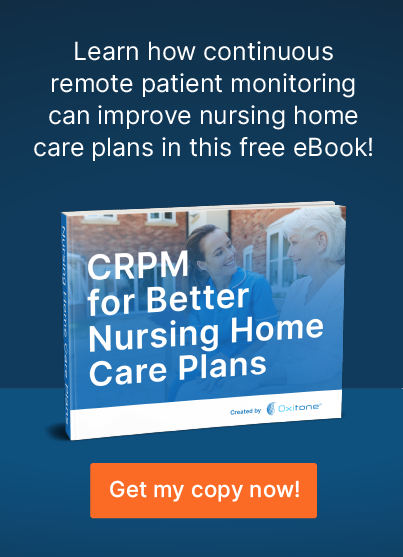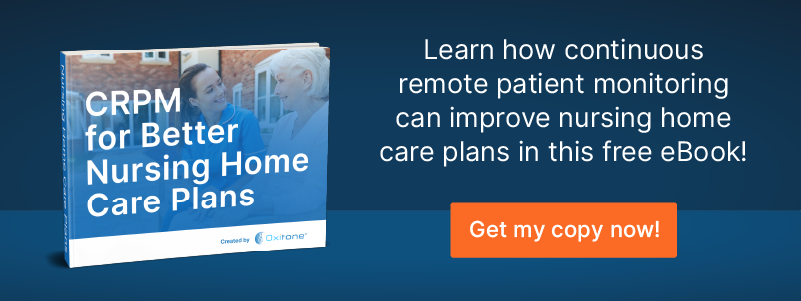Remote patient monitoring has been discussed for many years as a solution that could lead to lower costs, improved patient outcomes, and better access to healthcare in underserved areas. Progress toward implementing these initiatives has proven frustratingly slow for reasons ranging from healthcare reimbursement policies to privacy concerns. One major hurdle has been in the technological approach. A typical remote patient monitoring kit typically comprises many devices that depend, at some level, on the ability of patients to know how to use them and remember to take their readings.
Since these multi-device kits rely on patient compliance, they can produce sporadic or unreliable data that lessen the value of the remote patient monitoring experience.
Change is here, however. Through innovation from companies such as Oxitone, it’s possible to outfit patients with a single, wearable monitoring device. Worn on the wrist like a watch, this hospital-grade device automatically captures multiple vital sign parameters and transmits data over wireless networks to electronic patient records for review in real time. With the potential for integration with artificial intelligence tools, the device now becomes a sentinel, ready to sound the alarm for individuals struggling with chronic conditions, such as COPD.
Fueled by lessons learned from the COVID-19 pandemic, the new vision is accelerating toward a system of continuous remote patient monitoring.
The Compliance Obstacle in Remote Patient Monitoring Kit
Recent years have seen the helpful development of a range of self-serve, off-the-shelf medical monitoring devices that can be brought into the home for routine monitoring of various health vital signs.
These include devices such as glucometers to measure blood sugar levels, pulse oximeters for oxygen saturation, and blood pressure cuffs for monitoring hypertension, among many other examples.
Besides providing data that is in different technological formats, making it difficult for devices to communicate results into electronic health record systems, the multi-device remote patient monitoring kit also struggles with issues with patient compliance.
For example, in a May 2021 survey, physicians involved in remote cardiac patient monitoring programs reported that a significant percentage of patients were not connecting to the system and following its protocols.
Certain compliance issues are beyond a patient’s control. For example, researchers are studying ways to improve battery usage on smartphones. One study found an over 50% increase in compliance in remote patient monitoring when applying special techniques designed to extend smartphone battery life.
With the impetus of lessons from the COVID-19 pandemic, remote patient monitoring capabilities are an increasingly urgent priority for doctors, hospitals, and other providers. Oxitone’s multi-parameter device approach represents a promising solution to make remote patient monitoring easier, more cost-efficient, and more patient-effective.
Oxitone: The One Device That You Need
More providers are producing single-variable devices for remote patient monitoring. But individuals with chronic conditions often need to keep track of multiple data points to take the best care of their health. It’s not realistic for these individuals to carry, wear, or connect to multiple devices all day, every day.
Oxitone has a solution. The Oxitone 1000M is a wrist-worn, hospital-grade medical device that helps guide the care of individuals with various chronic conditions, especially COPD. The Oxitone 1000M captures, processes, and transmits data to health records over wireless or Bluetooth networks.
The 1000M currently measures a wide range of parameters, including oxygen saturation, pulse rate, heart rate variability, activity, skin temperature, and instances of sleep apnea. In addition to being part of managing a chronic disease, many of these parameters are also signals for COVID-19 as a respiratory disease. For instance, doctors can judge a patient’s need for care based on the percentage of oxygen in their blood. Lower levels that make it harder to breathe increase the need for in-person care.
As a result of COVID-19, in-person care is now a precious resource that has to be carefully managed through approaches such as remote “touchless” patient monitoring. If providers can see the data from a suspected COVID-19 patient, they can make more informed decisions on whether someone needs to be hospitalized or otherwise treated.
Advantages of Replacing Remote Patient Monitoring with One Device
Providing patients with one device not only increases compliance but also engagement with care. The more that patients know and understand the data about their conditions, the more likely they are to adhere to doctors’ instructions.
Putting multi-parameters into a single wrist-worn device provides more convenience for the patient. The Oxitone 1000M also includes a proprietary FlexSense™ elastic optical aperture that embraces the ulna bone and doesn’t affect local blood flow. It is a potentially less intrusive way of recording the vital signs that doctors need in order to decide on care.
Moreover, the continuous nature of the data flow is freeing for both the patient and their care team. Cloud-based artificial intelligence allows for alarms to be set when patients drop below baseline. Care teams do not have to be manually monitoring every minute, and patients know that they are under the careful watch of the device, bringing peace of mind to their day.
Partner with Oxitone
Multi-parameter devices such as the Oxitone 1000M also allow for more than reactive care. With the continuous integration of data comes the power for physicians to predict exacerbations in chronic care. In doing so, they drastically improve patient compliance and help make better clinical decisions, all while saving on healthcare costs at scale.
Here at Oxitone, we boost value-based healthcare by delivering extraordinary patient, clinical, and economical outcomes at reduced medical utilization and cost. Patients need a prompt response to emergencies. Physicians need an easy and timely follow-up with patients. Our mission is to transform chronic disease management and help save lives worldwide.
Let’s save lives together! To see how we help remote patient monitoring companies and physicians improve the management and care of high-risk patients, contact us today!


